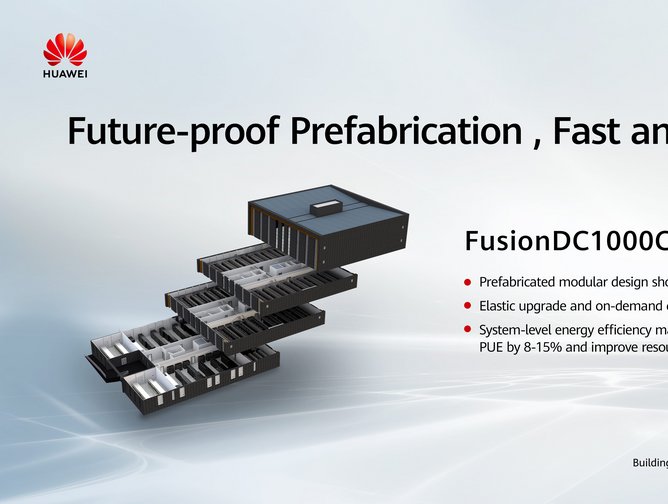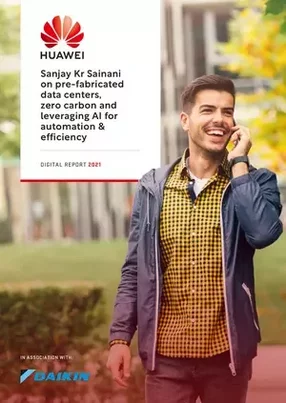Everyday, more than three billion people around the world use Huawei products, to connect with others or for solitary internet browsing.
As one of the leading global providers of information and communications technology, infrastructure and smart devices, Huawei’s 197,000 employees are based across 170 countries.
The mission at Huawei is to build a fully connected, intelligent world, through bringing digital technology to every person, home and organisation.
As the world shifts to become more sustainable, the Digital Power Business Group within Huawei is working to integrate digital and power electronic technologies for a greener future.
Data Centre caught up with Sanjay Kr Sainani, the Global SVP & CTO at Huawei. Sainani is responsible for global business development and for innovation in Data Centre Solution offerings.
Sainani has worked with Huawei for seven years and in that time, he has seen a lot of change within the business.
“My experience at Huawei has been thrilling”, explains Sainani. “In 2014, the year I joined Huawei, our global revenue was US$46bn. In 2020, it was in excess of US$120bn. We have made huge inroads into the Cloud, 5G & Enterprise markets with IT, Cloud, Unified Communications, Big Data, AI, ML & Data Centre Solutions.”
5G is one of Huawei’s most powerful tools. The fifth generation of mobile phone technology known as 5G follows on from 4G, offering users faster connectivity.
“Our 5G roll outs lead the way in the telecom infrastructure deployments world-wide”, Sainani says proudly. “Our leadership in Consumer scaled new peaks, although there have been strong head-winds in this space, but with the launch of our new Harmony OS, we believe Huawei will create another major ecosystem in consumer and wearable space. We are the fastest growing Cloud Services Provider globally and our investment in the Cloud and the Cloud ecosystem is producing strong results.”
One of the most important technologies for managing energy efficiency is digital power, where-in bits manage watts. Huawei has been a late comer to the digital power party after returning into the business in 2010, but as of 2020, Huawei’s digital power is a force to be reckoned with.
Huawei’s technology focus on digital power is by innovation through:
- Converging energy and information flows to use “Bits to Manage Watts”
- Developing a clean power system with a focus on Solar & Energy Storage
- Promoting comprehensive electrification in the transport industry
- Zero Carbon Transformative Solutions within ICGT Infrastructure
- Intelligent and Low LCOE energy storage
- Open Energy Cloud, as an enablement platform for the Energy Internet ecosystem.
“For the fourth year in succession, Huawei is the world’s largest provider of PV Inverters for Grid scale PV power plants”, said Sainani. “Our Data Centre business has revolutionised the Pre-fabricated Modular Data Centre build, and we are today by far the largest prefab data centre provider globally. The rapid deployment of 5G is supported by MIMO rectifier solutions that are both efficient, compact, future proof and more importantly robust in extreme environments. Our latest offering is solutions for the EV industry that include charging stations as well as drive trains as an OEM to EV manufacturers.”
However, Huawei is also taking care to balance its technological aspirations with its environmental concerns.
“As both generations moves towards solar and renewables and users move towards an all electric age,,Huawei is very well positioned to leverage its expertise and experience to bring more value to our customers in the quest towards a Zero Carbon Society”, said Sainani.
Study abroad created an understanding for unique perspectives
Sainani has studied, interned and worked abroad and the accumulated experiences have taught him about the keys to growing a sustainable business.
“The academic journey has been very full-filling”, said Sainani. “I did my BS in Power Electronics in 1988, which now in retrospect, was 15 years ahead of its time. We studied and conducted lab simulations on cutting edge power conversion technologies as practical applications were not yet industrialised. Study and project work included variable speed drives with regenerative braking, MV Solid State Power control, Converters, Inverters which are the backbone today for Power Converters, Electric Vehicles and Charging Systems.”
“My study in Japan on an AOTS scholarship was focused on Power Electronics & Robotics”, explains Sainani. “Again, it was too early for its day in the spotlight! My Japan experience gave me a very strong insight into the Culture of Quality, JIT manufacturing systems and more importantly business discipline and respect for time.
“Studies in the US mid-way in my career exposed me to management practices prevalent in regions of the world, unique perspectives and how attitudes and culture shape organisational behaviour, which is key to building a sustainable and growing business that is admired by both employees and customers.”
Partnerships and progress
“At Huawei we recognised the gap in the Data Centre build market”, said Sainani. “The traditional approach of build to design resulted in two procurement cycles, and delivery focused on best of breed, component based solution.”
Sainani believes that customers today expect Data Centre build-outs in matter of months, not years. The expectation is of a system level performance and not limited to compliance to product specifications.
“At Huawei our EPC delivery model of Prefab Modular Data Centre is based on the four main values:
- Single Point of responsibility/Turnkey Contract
- Fixed price contracts with no-cost overruns
- Short TTM
- System Level Performance KPI’s
To be able to deliver this, Huawei has an extensive eco-system of Product and Services Delivery OEM’s that include MV, LV, DG, Chiller Vendors, Civil, MEP Contractors and CE firms.”
It all started with the humble “Data Centre in a box” or its predecessor “telecom shelter.
“As customers were under pressure to build and deploy Data Centre Services within a very short period of time, while improving the quality of build and reducing the cost, Huawei put its Data Centre technology expertise and project delivery experience to test”, said Sainani. “Our turnkey solution is an EPC delivery model with a fixed price contract. The Prefabricated Solution relies on much of the construction and fit-out to be done at the factory to provide a consistent and high quality factory finish. The Modular aspect of the solution allows Huawei to build a Data Centre customised to fit the customer’s business/application scenario while using standardised building blocks, thereby offering a very high level of modularity and scalability at a building level. Huawei offers turnkey prefab data center solutions from 1 MW to 100+ MW campus. We have successfully delivered over 100MW of prefab Data centres globally and have another 75MW of Data Centres on order. We are able to offer turnkey builds including Design & Build from 6 months to 15 months depending mainly on size and statutory approval time-lines.”
Huawei’s experience with Daikin began in China and both companies are very technology focused and customer centric.
“In many of our turnkey EPC Prefab Modular Data Centre Build projects, Daikin Chiller Solutions were a good fit for the performance and TCO expectations and coupled with local support infrastructure to provide high availability during project life-cycle and so has been a vendor of choice accepted by customer and their technical engineers. We are also working together to explore innovative cooling solutions to further reduce the cooling energy consumption and making the overall solution simple and intelligent.”
My Passion, from the environment to energy efficiency
Another area where Sainani has spent a lot of time working on is Huawei’s energy efficiency and sustainability solutions.
“This is an area I am very passionate about”, said Sainani. “A lot of my work on innovation is with focus on future proof solutions that are available, energy efficient and sustainable.
Work is being done in four areas:
Power Conversion & Energy Storage technology
“Our UPS technology offers the industry first hot-swappable 100KW UPS module in 3U form factor. Allowing a 1.2 MW UPS footprint to be that of 2 IT cabinets. All of this at an operating efficiency in excess of 96.5%.
“Our Smart Li Battery is a LiFP battery offering, is completely modular and offers twice the life-cycle, 70% reduction in weight and footprint as compared to traditional batteries.”
Heat extraction Management
“Efficient and effective heat extraction is key at component and system level. For example Smart engineering allows us to extract heat from our UPS modules very efficiently thereby allowing us to have a compact 3 U form factor.
“Use of special materials for Evaporator, EC fan motors, Variable Speed Compressors, Thin wet Film humidifiers, Indirect evaporative cooling are examples of making heat extraction from components or from data centers efficient and effective.”
Leverage AI & ML for Availability and System level Efficiency
“Embedded IoT provides us with a lot of real-time data, which can be used to predict health of systems and in case of cooling can assist to identify through regression analysis the best efficiency operating point of the system which includes fans, pumps, compressors etc.
“In addition AI & ML allows unattended and remote maintenance and operation possible with high degree of confidence.”
Technology, Materials and Processes for Sustainability
“New Silicon in power electronics should help us transform copper and magnetic core to Silicon with MV UPS’s. Custom composites improve heat transfer making cooling machines more efficient. Use of Modular Prefab helps to reduce concrete in the Data Centre Construction thereby reducing the embedded carbon footprint.”
Huawei ensuring a carbon neutral future
The next 12 months and beyond for Sainani and Huawei, will be focused on maintaining stability between technological progress and heading towards carbon neutrality.
“Today, carbon neutrality is a mission shared by the entire world”, said Sainani. “Major economies have successfully implemented new green deals which have begun a new round of economic development and innovation. We believe this will further drive extensive and profound economic and social transformation that will revolutionise energy production and consumption. Our focus over the next many months is to restructure our organisation - Digital Power Company of Huawei to take advantage of this huge business opportunity.”



